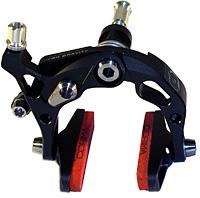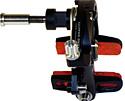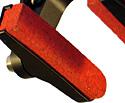
Recently on Cyclingnews.com |
On test: Zero Gravity 0G-05 brakes, July 27, 2005
More power!
Zero Gravity brakes are undeniably amazingly light, but our first impression last year was that they lacked the sheer stopping ability of other top brakes. Zero G went back to the drawing board and David Langley finds the revamped version has power aplenty.

|
Last year, Cyclingnews tech editor John Stevenson gave his first impressions of the astoundingly light Zero Gravity brakes. John was generally impressed but commented that the Zero G's were not quite as powerful as the Dura-Ace brakes that seemed to feature on just about every bike we road tested last year.
To our considerable surprise, Zero Gravity designer and head honch Ted Ciamillo was on the case almost immediately, tweaking the already-ingenious design of the Zero G's cam so that the front brake delivered more power toward the end of the stroke, as the pad hit the rim.
I have used Shimano brakes (600/Ultegra or Dura-ace) for most of the last 15 years until a couple of years ago I got my mitts on some Campagnolo Delta brakes. Now, I freely admit that the Deltas are… idiosyncratic in terms of their stopping ability and set-up, but I like their looks and usefulness for delicately slowing you down in a bunch without putting you over the bars.
My fellow Cyclingnews test crew riders always pooh-poohed the Deltas and took great delight in handing me this set of Zero Gravity brakes to complement the carbon FSA RD488 wheels we featured a few weeks ago. The Deltas having shorter pads than the modern standard, finding carbon-compatible pads for them was going to be tricky. Easier to change my brakes, and after several weeks of using the Zero Gravities, I won't be going back.
|
|
|
|
|
|
|
|
|
Installation
A minor quibble encountered during installation was that the 5 mm Allen Key nuts which fix the brakes to the frame were not sufficiently threaded to allow the rear brake to be securely attached. Hence, I used the old nut from the Delta set. Additionally, the cable clamps on the front and rear units were machined differently. The front set have a pronounced housing into which an asymmetric washer fits as it squashes the cable into place. The cable clamp on the rear unit lacks most of this feature and utilises a symmetric round washer. I personally found it a little bit fiddly to get the cables set just right, and feel that a more pronounced cable groove and identical machining, front and back, would make installation easier.
Style and design
While I was initially reluctant to replace my much-loved Deltas, the Zero Gravity brakes have grown on me. They are CNC machined out of 7075 grade Aluminium. Being jet black, they actually set off the midnight purple of my Steel Colnago rather well. They should make a clean understated contribution to any frame they are mounted to, allowing the frame to hold the limelight. To the eye, the 2005 model looks very similar to the 2004 version, although, incredibly, it is fractionally lighter. It has been re-engineered to produce a 2:1 mechanical advantage yielding 25 percent more clamping force, equivalent to that of the modern-day Dura-ace calipers. The quick-release mechanism has also been improved to allow for a wider gape when the wheels are being changed. I had no problems getting the relatively fat Continental 25 Tubulars on the FSA test wheels on/off. Fine-centering the calipers is easily achieved with a 13 mm cone wrench, or an adjustable spanner.
The only functional quibble became pronounced when I blew a spoke in my rear wheel (fortunately an old 36-spoke training wheel, not a low-spoke count uber-wheel). With Shimano brakes or Campagnolo Ergopower shifters one can widen the pad spacing of the brakes while moving, but with the Zero Gravities one must first stop rolling then manually pincer the pads onto the rim in order to flick the toggle to the larger gape setting. This would only really matter during a race where having to stop and make the adjustment might mean a painful effort in re-joining the bunch. Of course, if you are racing on low-spoke-count wheels to begin with, no amount of gape-widening is going to prevent you from requiring a wheel-change anyway.
Weight
These things are not branded Zero Gravity for nothing. The Deltas came in at over 500g/pair whilst the Zero Gravities are 170g/pair. Embarrassing, really! A fairer comparison is with Shimano's 314g/pair Dura-Ace brakes,which the Zero Gravities blow out of the water on the scale.
Performance - cork vs rubber
I used the Zero Gravities with two pad/wheel set-ups. Far and away the most successful was the pairing of the Kool Stop Dura "Blacks" pads supplied as an option with the brakes and standard alloy rims. (Current brakes come with Girs pads from France, which are reportedly even better). The wheels in question were home-built 36-hole Rigida DPX rims laced 3-cross onto Ultegra hubs. This is a great combination. I have ridden similar Rigida DP18 rims with Dura-ace (1998) calipers with KoolStop rubber and cannot remember the combination being as effective. And I should state that I have never used anything but bog-standard cable housing.
With braking so light yet responsive I almost had a few moments on that first outing when grabbing a bit too much front end on a descent chock full of hairpins north of Sydney (mental note - take it easy next time!). While my feel for the road through these brakes has necessarily had to change somewhat, now that I've adjusted I'm so impressed that I don't think I'll be going back. The Deltas are museum pieces anyway, right? These things are staying on my machine.
I also did about 500 km with Corima cork pads on FSA carbon rims. As stated in the FSA review, the combination of cork pad and carbon rim is nothing to crow about. The stopping power is considerably worse than that of the Delta brakes on standard rims. After ineffectual feathering, the combination suddenly starts to grip in spurts when considerable force is applied. It makes for some nervous moments when sudden braking is required. As Sydney has been in drought for some time, I (thankfully) did not get the opportunity to see what would happen in the wet. However, the cork-carbon issue is a problem regardless of what brand of calipers are being used.
Summary
Maybe I'm just a soft touch but I've become a fan of a product I never expected to rave about. These brakes look flash, weigh nothing, and do the job exceptionally well. No wonder they are being increasingly spotted on all sorts of bikes of professional teams at more major tours.
Suggested retail price: US$399.95/pr
Weight: 170g/pr
Pro: Very low weight; great stopping power
Con: Idiosyncratic cable clamps
More information: www.zerogravitybike.com
Cyclingnews rating: ![]()






